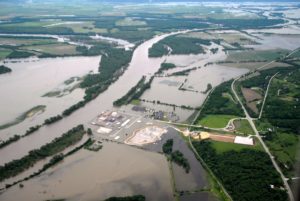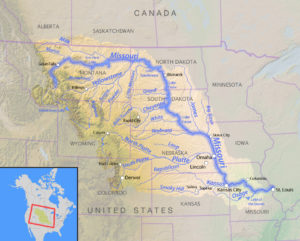Levee failures on the Missouri River disrupt agriculture economy and infrastructure systems
The Missouri River, the longest river in North America, has played a critical role in sustaining communities in the midwest for centuries, serving as a source of drinking water, hydroelectric power, wildlife habitat, method of transportation, shipping, farming, recreation, and more. Recently, due to irregularly high rainfall, this natural asset has turned into an uncontrollable hazard. Rural towns across large swaths of the region are experiencing firsthand a taste of the challenges that lay before them as the changing climate continues to alter the capacity and behavior of this enormous and vital resource.
What happened?
On March 13, several states in the midwest were hit by what meteorologists refer to as a “bomb cyclone” or a “bombogenesis”, which is a powerful storm characterized by rapidly-intensifying areas of low pressure. This storm brought with it heavy rains which, combined with the runoff from large quantities of melted snow and ice, raised the Missouri river to threatening levels almost immediately. The rising water quickly overwhelmed and breached as many as 62 levees, with hundreds of miles of levees sustaining critical damage. Over the following several weeks, communities surrounding the Missouri, which are predominantly small farming towns, were devastated by severe flooding. Thousands were forced to evacuate and abandon their land, which was also their livelihood. In Nebraska alone, 74 cities declared states of emergency. Iowa’s governor announced that over 23,000 structures were damaged, incurring a total impact of over $1.6 billion. Bridges were destroyed, roads and rail lines were washed away, farms were completely submerged, and at least three people were killed as a result of the failing levee system.
Why?

These levee breaches were not entirely unexpected by those familiar with their function. The Missouri River levee infrastructure is aging and is not evenly regulated. In fact, in 2017 the American Society of Civil Engineers gave the country’s levee system a D grade. Levees are managed by local government agencies called levee districts that do not often coordinate or even follow the same guidelines. Levee districts’ finances and resources are strained by the increased frequency of flood events, requiring increased testing of mitigating structures. This insufficient levee maintenance system could be partially responsible for the decreased capacity of the infrastructure.
Impact
Though conditions have been worsening for years, in light of the disastrous flooding occurring this year many people have said that this season was the last straw and that farming near the river may not be possible much longer without major river management changes. Tom Waters, chairman of the Missouri Levee and Drainage District Association compared the situation to “driving on gravel roads [while] trying to handle interstate traffic.” Though this month’s event was particularly devastating, it isn’t the first time we’re seeing these problems. According to the American Farm Bureau, farms filing for bankruptcy protection rose 19% in the midwest in 2018 to the highest level seen in a decade.
But it wasn’t just rural farmers who were impacted by this disaster. The Pine Ridge Indian Reservation in southern South Dakota, covering nearly 3500 square miles and home to more than 40,000 members of the Oglala Sioux Tribe, was devastated by the flooding. The impact of the flooding was exacerbated by the reservation’s lack of training, manpower, and equipment necessary to prepare for and respond to a large-scale disaster. The area’s minimal emergency management channels led to thousands being cut off from critical emergency services and recovery resources. Thousands are still stuck in their homes waiting for help to arrive by boat or horseback, as many of the roads in residential areas are still impassible. Tribal officials said the federal Bureau of Indian Affairs has provided equipment and manpower to help deliver resources and recover critical infrastructure, however, the road ahead is still long and arduous, especially given the collective fear that climate change will make these events more severe and frequent.
With little left to lose, displaced farmers and community members are desperately seeking accountability. Many are pointing the finger at the Army Corps of Engineers, who manage the Missouri River by operating a series of dams to help control water levels. Following the recent flooding, several lawmakers criticized the Army Corps of Engineers for not prioritizing flood control over commercial interests. In 2017, landowners from four Midwestern states won a lawsuit against the Army Corps of Engineers that claimed the continued floods were tantamount to seizure of their property. Army Corps emergency management specialist Mike Dulin maintains that there was not much that could have been done to prevent the floods the region has experienced.
What’s being done?
In the weeks following these flood events, policymakers have made many symbolic, but few substantive, efforts towards recovery. Officials in several states have promised to erect temporary bridges and begin work swiftly on the most pressing infrastructure failures. Despite this commitment, residents in the affected areas will likely experience disruptions for weeks, if not months, given that several hundred miles of state highways were destroyed. Only time will tell if government commitment to rebuilding a resilient levee system will fall in line with the $80 billion investment over ten years as recommended by American Society of Civil Engineers. In general, the events of the last month have raised serious questions for residents regarding how rivers should be controlled, who should make those decisions, and how much protection should be given to vulnerable communities.
Resilience Implications

Generally, scientists have reached the consensus that climate change is causing natural disasters and weather events to be more severe, longer, and more frequent. Missouri farmer Roger Ideker noted that “It seems like any type of significant rain causes a flood. It’s just been almost one flood after another, and they seem to increase in intensity.” He says that members of his community have no doubt that the river has changed significantly in just the last 10-12 years. Gerald Galloway, a University of Maryland professor of engineering considered a top expert in flood management, suggested that to accommodate these changes the Army Corps should rebuild levees much higher, as was done in post-Katrina New Orleans. Ideker, however, has witnessed attempts at mitigating the regular floods by simply rebuilding levees higher, and recognizes that this is just a band-aid solution that postpones the inevitable breach as storms continue to grow in magnitude. Simply building taller levees leaves the river with no way to release pressure, which is exactly what lead to the Great Flood of 1927 and displaced one million people. Though some are committed to remaining in their communities and rebuilding their lives, many in region found the levee breaches to be the straw that broke the camel’s back, adding to the already discouraging financial situations and mental stress of a modern farming lifestyle, noted Roger Johnson, president of the National Farmers Union.
Environmental activists hope that, if there is a silver lining to this crisis, it is that people will begin seeing climate change as a national security threat, and one that isn’t limited to coastal communities. Heather Navarro, executive director of the Missouri Coalition for the Environment, contends that her ideal mitigation strategy would be for the Army Corps to buy out farmers living in floodplains, remove levees, and transform farmland back into wetlands. Though this may seem far-fetched to people currently living in those areas, this is the kind of transformative and preventative action that needs to be debated if we want to avoid even more catastrophic events in the future.
Sources and Additional Reading
‘Breaches Everywhere’: Flooding Bursts Midwest Levees, and Tough Questions Follow – New York Times
‘It’s Probably Over for Us’: Record Flooding Pummels Midwest When Farmers Can Least Afford It – New York Times
Widespread Floods Test Resilience of Midwest – U.S. Army Corps of Engineers
Like ‘House Arrest’: Flooded Roads and Swamped Bridges Strand Nebraskans – New York Times
‘Midwest floods foreshadow national security threat posed by climate change – PBS
A State of Emergency’: Native Americans Stranded for Days by Flooding – New York Times
Act of God? Or government? In fight over flood, farmers blame Army Corps of Engineers – The Kansas City Star
What is a ‘bomb cyclone’? – Fox News
